
Pillow Talk: The Surprising Link Between Your Pillowcase and Glowing Skin
We all know that beauty sleep is real—but did you know your pillowcase could be sabotaging your glow? From breakouts to wrinkles, the fabric you rest your face on every night plays a bigger role in your skin’s health than you might think. Let’s dive into the science of sleep and skin, and uncover how small changes can lead to a fresher, brighter complexion.
Why Your Pillowcase Matters More Than You Think
While you sleep, your skin goes into repair mode—but it’s also pressed against your pillow for hours. That means oils, sweat, bacteria, and even leftover skincare products transfer onto the fabric, creating a breeding ground for irritation and clogged pores. The type of fabric you use can either help or hurt this process.
The Best (and Worst) Fabrics for Your Skin
Silk & Satin: The Skin Saviors
Silk and satin pillowcases aren’t just luxurious—they’re skin-friendly. Their smooth surface reduces friction, preventing sleep wrinkles and hair breakage. Plus, they absorb less moisture than cotton, helping your skin stay hydrated.
Cotton: The Double-Edged Sword
While breathable, cotton absorbs moisture and oils from your skin, which can leave it dry. It also creates more friction, contributing to sleep lines over time. If you prefer cotton, opt for a high-thread-count, organic version and wash it frequently.
Polyester & Rough Fabrics: The Breakout Triggers
Synthetic fabrics like polyester trap heat and bacteria, increasing the risk of irritation and acne. If you’re prone to breakouts, avoid these materials.
Sleep Position & Skin Health
Your favorite sleep position also impacts your skin:
- Back sleeping is best—it prevents wrinkles and keeps oils from smearing into your pores.
- Side sleeping can cause “sleep wrinkles” and uneven pressure on the skin.
- Stomach sleeping is the worst—it strains your neck and presses your face into bacteria buildup.
Bedtime Habits for Better Skin
Beyond your pillowcase, these habits can help you wake up with a healthier glow:
- Wash your face before bed (no exceptions!).
- Change your pillowcase every 3-4 days (or weekly at minimum).
- Use a silk or satin pillowcase if you’re acne-prone or concerned about wrinkles.
- Sleep on a clean, fragrance-free detergent to avoid irritation.
Final Thoughts: Upgrade Your Sleep for Better Skin
Your pillowcase is more than just a bedtime accessory—it’s a key player in your skincare routine. By choosing the right fabric, adjusting your sleep position, and keeping your bedding fresh, you can wake up to smoother, clearer, and more radiant skin. Sweet dreams and even sweeter results!
Have you noticed a difference after switching pillowcases? Share your experience in the comments!
RELATED POSTS
View all


